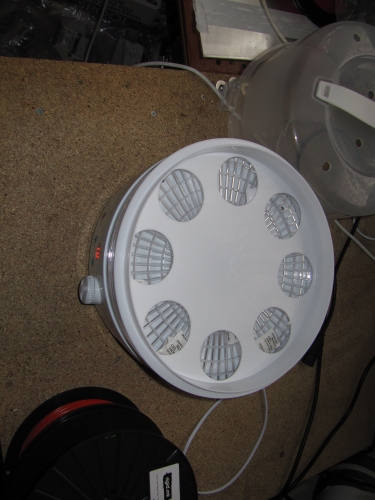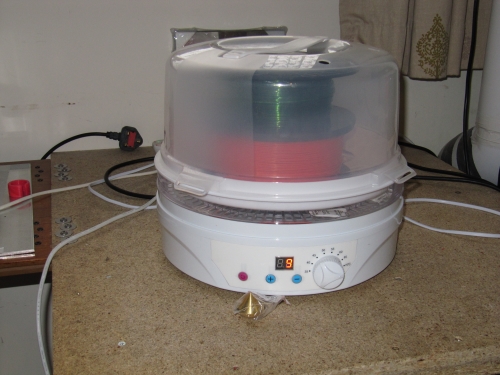PETG Drying
-
70C 6 hr here
-
I dry it around 60-65C for 2-4 hours, in a dehydrator. I monitor the humidity in the dry box as well, and dry it again if it hits 25-30%. That seems to be below the hissing & popping point, which is good.
Be cautious about going too high in temperature - some spools can begin to deform, and you'll be plagued with feed problems from then on.
-
Isn't drying more a product of the difference in humidity and airflow than temperature alone.
I.e. even a marginal temperature difference will dry the filament given enough airflow with low enough humidity, and even a substantial temperature difference can only absorb so much water without airflow.
-
@bearer That's my understanding. If you have a vacuum chamber you could dry it even faster since the boiling point of water drops in a vacuum.
-
When talking about humidity you need to be careful, relative humidity (expressed in %) tells you how saturated air is.
So at 25°C air can have 20g of water per kg of air and that is 100% humidity. If you raise temperature to 65°C, air can take up to 204g, so that means relative humidity when you have 20g/kg is 32%
So at "normal" conditions ant 25°C/50%rh you have 10g/kg and when you heat it up to 65°C you still have 10g/kg, so relative humidity is 6%
But I think that temperature also plays in drying, it always helps if you get molecules moving faster.I once found these somewhere, and from what I tested they work. You basically set temperature as high as possible before glass transition.
PLA - 4h@45°C
ABS - 2h@60°C
PETG - 2h@65°C
NYLON - 12h@70°C
PVA - 4h@45°C
TPU/TPE - 4h@50°C
ASA - 4h@60°C
PP - 6h@55°C
Dessicant - 6h@65°CEdit: Missing temperature
-
Thanks all.
With metal powders if you picked the wrong temperature it sucked water out of the air rather than dry. I was worried that a too lower temperature may have the same issue with plastic.
The food dehydrators look like a good option. Upto 70C ish and same price. Looks like I will need to cut out some trays but at £20-30ish I'm not overly concerned about cutting it up!
I had thought that I maybe wasting time trying to sort part cooling ducts when my real issue was wet polymer. That said all of the worst edges are on one side of the part, so still safely in the domain of part cooling issues.
I will order a dehydrator soon though.
-
@doctrucker said in PETG Drying:
Looks like I will need to cut out some trays
or print an extension. I just mocked up some 30 degrees sections and snapped together and on a tray with enough height to hold my widest spool
-
Wes,
Susi from "Rigid Ink" once sent me details of how to make a home brew filament dryer which she claimed worked really well. It's still on my "todo" list of things to make so I haven't got around to it but I'll see if I can dig out her email and forward it to you.
-
@deckingman I would be interested in that as well ...
-
@deckingman Me also please.
-
Some companies are now making real-time filament drying:
- Fyladry (interview here: https://youtu.be/-FvGRm7I1Dc?t=307)
- Thordsen 3D (interview here: https://youtu.be/0cj6dqMgja4?t=1032)
-
Ok, here is what Susi from Rigid Ink sent me
But I haven't tried it so don't blame me .......
You need of of these https://www.amazon.co.uk/Digital-Food-Dryer-Dehydrator-temperature/dp/B008MPBK8G
and one of these https://www.amazon.co.uk/Whitefurze-Round-Cake-Plastic-White/dp/B00YJ83MHW
These are the pictures she sent


And this is what she said, quote:
"As you can see, I just put the silica gel sachets on the grill of the bottom segment, then the reels in the top part.
Hope this helps you out - I find it an essential addition for when printing with nylon-based materials and PVA.
Just don't go over the Glass Temperature of the filaments being dried. The exception is nylon (Tg is ~41°C) as it has a very high heat deflection point (compared to the Tg) - I usually dry that around 55-60°C."
End of quote............
-
This one looks like mine, but instead of buying the cake box, I just cut the middle of trays. It works.
But I like the idea of drying the silica gel at the same time. -
Thanks for the links. Will try at some point and report. Humidity sensor hooked up to Arduino may be investigated!
-
@doctrucker said in PETG Drying:
Thanks for the links. Will try at some point and report. Humidity sensor hooked up to Arduino may be investigated!
you can interface a humidity sensor to the Duet as well:
https://duet3d.dozuki.com/Wiki/Gcode#Section_M305_Set_temperature_sensor_parametersChannels 400, 401... are DHTxx temperature channels. The DATA line of the DHTxx must be connected to one of pins CS1, CS2... on the SPI bus. Specify the sensor type (11 for DHT11, 21 for DHT21 or 22 for DHT22) via the T-parameter. e.g. M305 P102 X401 T22 S"DHT temperature"
Channels 450, 451... are as 400, 401... but specify the corresponding humidity sensor of the DHTxx
So in theory you could have heaters/fans connected to a filament chamber that was controlled by the Duet and also fed the printer.
-
@t3p3tony sounds good, the mirror of a hopper pre-heat/dryer on a molding machine. Neat, and could keep the filament dust free too. I'll bare that in mind and ensure anything I buy for it can be ported across.
-
@fma said in PETG Drying:
Some companies are now making real-time filament drying:
- Fyladry (interview here: https://youtu.be/-FvGRm7I1Dc?t=307)
- Thordsen 3D (interview here: https://youtu.be/0cj6dqMgja4?t=1032)
Filadry its a scam, Fake specs and low quality product. Its like an anet dryer.
-
I'm not surprised. This is something I would not buy until I see good reviews with decent testing setup.
-
I'm the one who got @deckingman's wet PETG, I've actually used it all up now (thanks again!), and used it to drive development of my vacuum filament dryer.
Here's the writeup -
That's a very nice write-up for your vacuum dryer. I may investigate it myself. I currently use a large food dehydrator for the filament, and a small convection oven for silica gel, but they each just dump the humidity back into the room. I already have a nice vacuum pump, so I'd save on that.